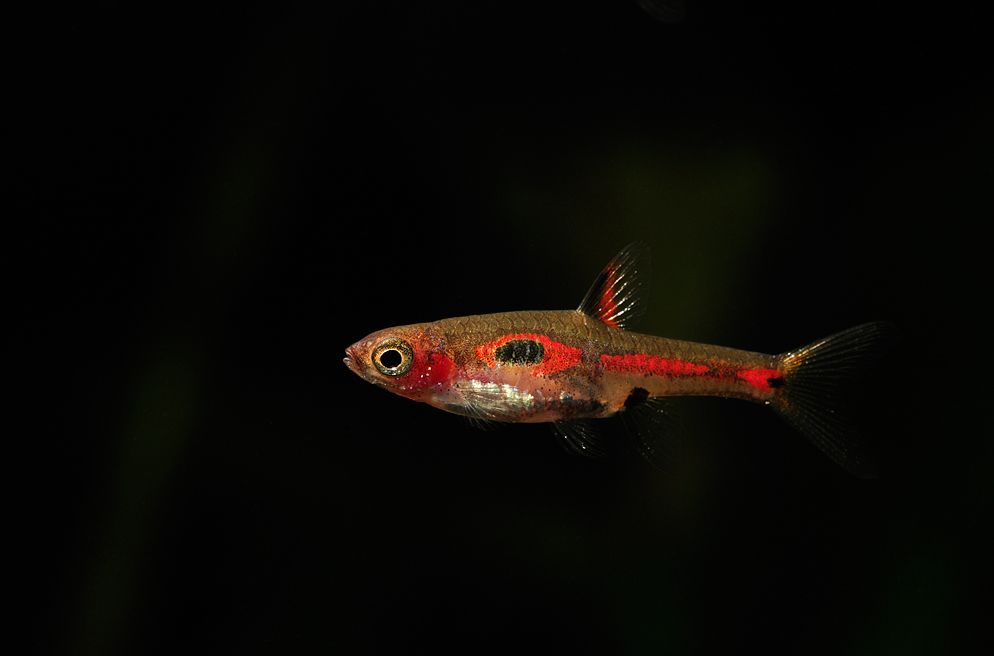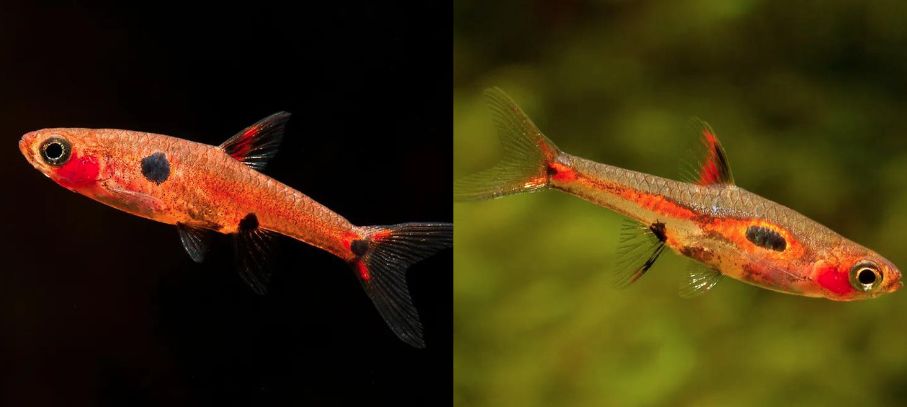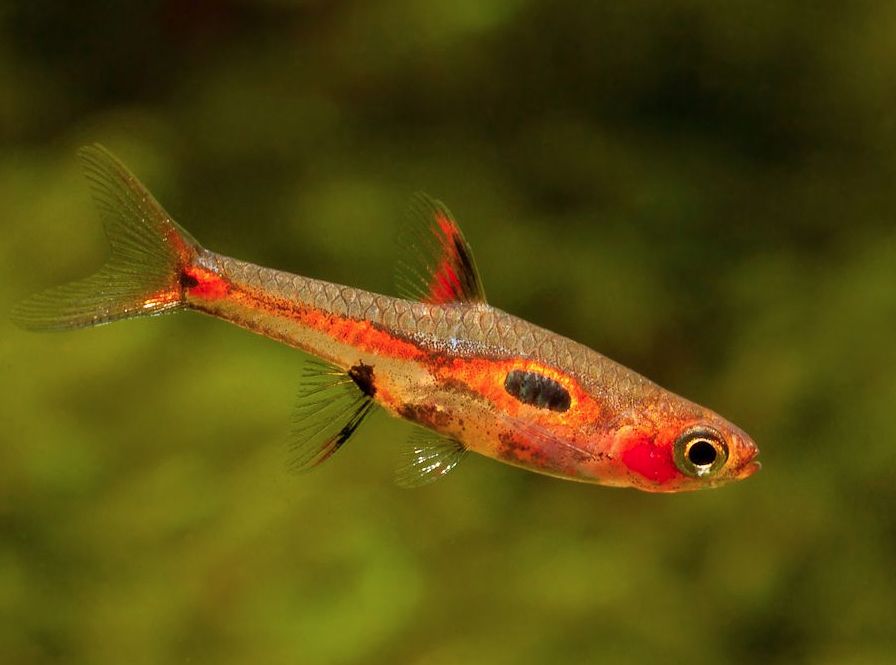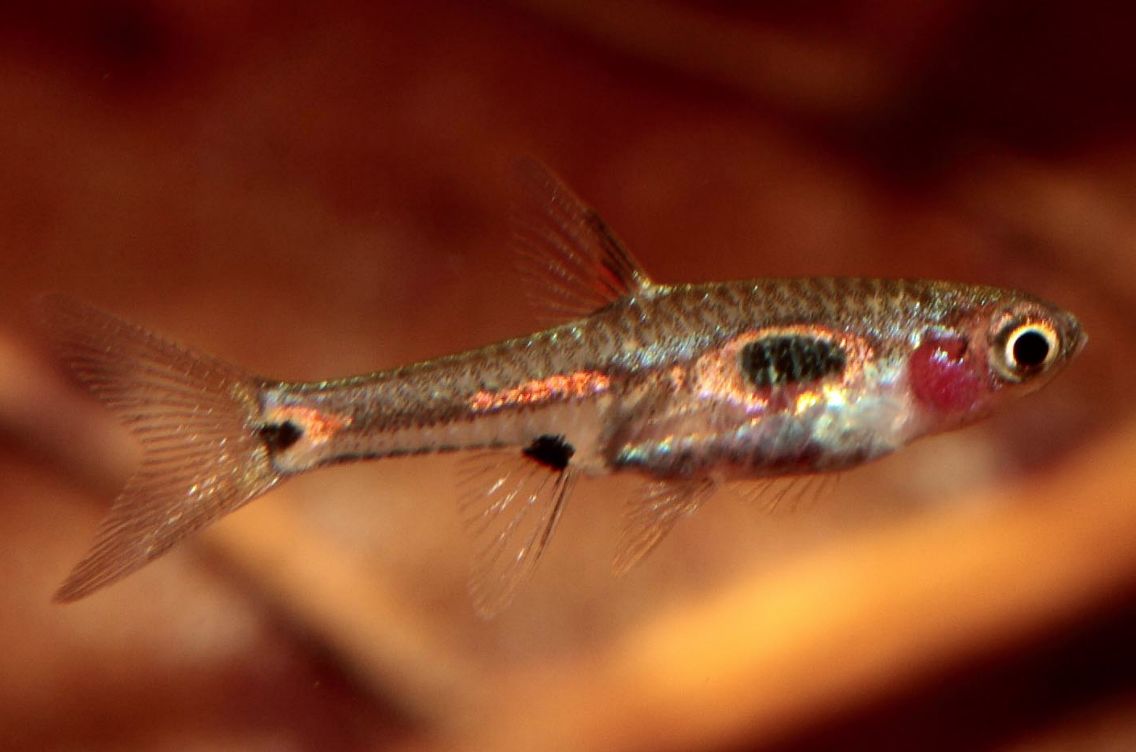Phoenix rasbora (Lat. Boraras merah) is a kind of ray-finned fish of the Boraras genus. Boraras merah is an extremely good-looking nano fish that is really popular among aquarists due to its schooling behavior, peaceful temper, and small size. This tiny fish is very friendly, and it is perfect for nano tanks. It even can be kept with all dwarf shrimps without risk!

Contents
Habitat in the wild
It is endemic to Borneo island. Its representatives were caught in the River Jelai Bila basin not far from Symatra city in the Indonesian province Kalimantan. The fish’s natural habitat stretches to the West from Jelai Bila interstream area, while the habitat of the related species B. brigittae, with which it can be encountered, stretches to the East.
Phoenix rasbora dwells in black waters and rivers connected with forest peat bogs. The water becomes brown due to tanning materials and other chemicals produced by degrading organic substances and substrate covered with fallen leaves, branches, and small wood.
Such mediums usually have rather soft (with insufficient hardness), acidic (pH is just 4,0) water, and they have rather a poor lighting due to the forest canopy above them. These biotopes are seriously endangered in most of Soth-East Asia territory because of natural rubber and oil palm plantations, building, and other human activity.
Description
The fish body length is 15 – 20 mm. Its specific name consists of two words: Boraras, which is the generic name Rasbora anagram, and mera, which comes from the Indonesian word mera, which means ‘red’ and indicates the fish main body color.
Phoenix rasbora is often taken for other Rasbora types by mistake. You must correctly identify the fish before getting it in a local pet shop. This kind is very similar to Boraras brigitta, and Boraras maculatus, but it can be identified by less homogenous red coloring and
Broken horizontal black stripe (if compared with Boraras brigittae).
| Characteristic | Description |
|---|---|
| Scientific Name | Boraras merah |
| Common Name | Phoenix Rasbora |
| Origin | Southeast Asia (Indonesia, Malaysia) |
| Size | Up to 1 inch (2.5 cm) |
| Lifespan | 2-3 years |
| Temperature Range | 75°F to 82°F (24°C to 28°C) |
| pH Range | 6.0 to 7.5 |
| Water Hardness | Soft to slightly hard (5-12 dGH) |
| Tank Size | Minimum 10 gallons (38 liters) |
| Behavior | Peaceful, shoaling fish |
| Diet | Omnivorous, small live and frozen foods |
| Tank Level | Middle to top |
| Compatibility | Suitable for peaceful community tanks |
| Breeding | Egg-scatterer, moderately difficult to breed |
| Special Considerations | Prefers dimly lit, well-planted aquariums |

Difficulties in keeping
Due to its bright coloring and peaceful, active temper, it is very popular and loved by aquarists. In a tank, phoenix rasbora is rather enduring, and as a rule, it will feel good in a wide range of water parameters, but it shows its color better if kept in warm, soft water in a group of at least 10 species.
Due to the small size of the adult species, you should avoid large-sized or quickly swimming tank mates. However, the fish will get on well with most small-sized peaceful fishes and spineless species.

Keeping in a tank
Lifespan
Provided with good care, its average lifespan varies from 3 to 5 years.
Tank capacity
Despite its small size, the fish still needs space to swim. Dominating males during the spawning period creates the territory they guard. Thus the school should be kept in a tank with a bottom size of not less than 45 * 30 cm.
Rasbora usually takes the upper and middle water layers, though you can often see it swimming and feeding also in the middle and bottom layers.
Water parameters
Optimal water parameters are the following:
- Temperature: 75°F to 82°F (24°C to 28°C)
- pH Level: 6.0 to 7.5
- Water Hardness: Soft to slightly hard (5-12 dGH)
It’s important to note that stability in water parameters is vital, as sudden fluctuations can stress the fish and make them susceptible to diseases. Regular water testing and maintenance are essential to ensure a stable and healthy environment for phoenix rasboras.
Additionally, using a reliable aquarium thermometer and pH testing kit will help you monitor the water temperature and pH level accurately. When setting up the aquarium, it’s a good idea to use a water conditioner to remove chlorine and chloramine from tap water and make it safe for the fish.
Plants, substrate, and decorations
This dwarf rasbora, usually encountered in bogs and streams with black water, will demonstrate all the best of its color and behavior in conditions similar to its native habitat. It will look better if you add some oak leaves or alike plant components.
Adding fluctuant and roots or tree branches to scatter the light getting into the tank is quite welcome and makes the tank look more natural. Soft sand substrate is the best choice here. You can also add some roots and snags to create shadowed areas. If you can’t find a snag of the proper shape, you can use a beech or an oak if you dry it well and remove the bark.
In the wild, this fish dwells in slowly flowing waters. It prefers tanks with many leaves, wood, and stones. Thus it is a perfect fish for a planted tank with pH less than 7.
Filtration
Filtration is desirable, but it shouldn’t be very strong since phoenix rasbora mainly dwells in lentic and slowly flowing waters, and it may feel uncomfortable with fast water flow.

Diet
As with other Boraras genera, phoenix rasbora is a micro predator that feeds on small insects, worms, crustaceans, and other zooplankton it can find in the wild.
In a tank, it will feed on artificial food of proper size but limit its diet only to these. Daily addition of small live and frozen food such as daphnia, brine shrimp, flakes, and pellets of high quality will ensure the fish best coloring and will favor the fish breeding.
Tank mates
This genus is a very peaceful one, but it’s not a perfect fish for a community tank because of its small size and a rather timid temper. This is a nano-schooling fish that are happy to live in a large school. This is when it demonstrates its natural behavior. The minimum number of fish in the school should be 10 or more. Ideally, they behave better in a school of 20 and more species.
Phoenix rasbora is an active fish you’ll enjoy watching. The more Rasbors you have in a school, the more often you’ll observe their schooling behavior in the tank. When kept in a larger school mera may start laying eggs. If the conditions are good for juveniles, they may grow in a common tank.
Perfect tank mates for phoenix rasbora are other genera of Boraras – chili rasbora, dwarf rasbora (Boraras maculatus), harlequin rasbora. Also, they are compatible with Corydoras (panda cory, pygmy cory, Corydoras julii, Adolfo’s catfish, etc.) and shrimps (cherry shrimp).

Male vs female
In most cases, distinguishing between male and female phoenix rasboras (Boraras merah) can be challenging, as the differences between the sexes are not as pronounced as in some other fish species. However, there are some subtle characteristics that may help differentiate males from females:
- Size: In some cases, males might be slightly smaller and more slender compared to females, but this difference is not always reliable or noticeable.
- Coloration: Males may exhibit slightly brighter or more intense colors, particularly during the breeding season. They could display deeper red or orange hues, especially on the body and fins.
- Body Shape: During the breeding season, males might develop a slightly more streamlined or elongated body shape to enhance their appearance and attract females.
- Behavior: During courtship and breeding, males can become more active and exhibit unique behaviors, such as displaying to the females or chasing them around the tank.
It’s essential to note that these differences can be subtle and not easily visible to the untrained eye. The most reliable way to determine the sex of phoenix rasboras is through observation during their breeding behavior. When they are ready to breed, the males may exhibit more noticeable color changes and courtship behaviors.
In community aquariums, distinguishing between males and females may not be crucial unless you are specifically planning to breed them. Phoenix rasboras are peaceful and can thrive in a mixed-sex group. If you are interested in breeding them, it’s best to provide them with appropriate breeding conditions, such as a well-planted tank and soft, slightly acidic water.
Breeding
Like many Cyprinidae species, phoenix rasbora spawns all the time without demonstrating any parent care about its offspring. This means that provided with proper keeping conditions and with males and females present in a tank relatively small amount of eggs will be in the tank. Thus, in a well-equipped, stable tank, a small number of juveniles may appear without the owner’s interference.
However, if you want to improve this number, you’ll need to use a bit more controlled approach. You should have one or several separate tanks of 10-15 liters capacity.
They should have dim lighting, with a bottom without substrate or a net of size enough not to trap the eggs that didn’t stick to the plants but, at the same time, that the adult species could not eat them.
The water should have pH 5,0-6,5, and the temperature close to the upper limit of the range mentioned above.
You also should add a bunch of Java moss or any other small-leaved plant that will fill half of the available space. Filtration is not really necessary, but if you want, you can use a small filter.
Then you should put two or three couples of well-prepared adult fish in each tank. It is reasonable to perform this slowly to avoid unnecessary stress on the fish, but if the conditions are good for them, they can start laying eggs the very next day.
Though this genus will definitely eat its eggs, it doesn’t haunt them actively as it happens with many small-sized Cyprinidae species. Once the spawning begins, it should continue every day.
The couples should be left in the tank, not more than for several days before you remove them since the first eggs should hatch on the 2nd day after the first spawning started. Tiny juveniles will live on their yolk bags for 24 hours more, and after this, they’ll need microscopic food.
In 7-10 days, they should become large enough to be able to eat brine shrimp, etc.